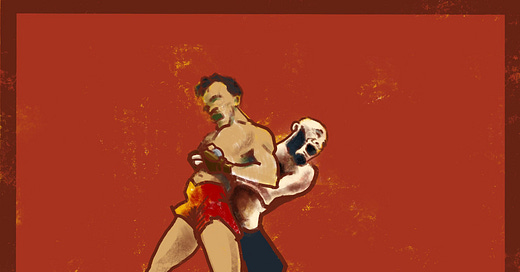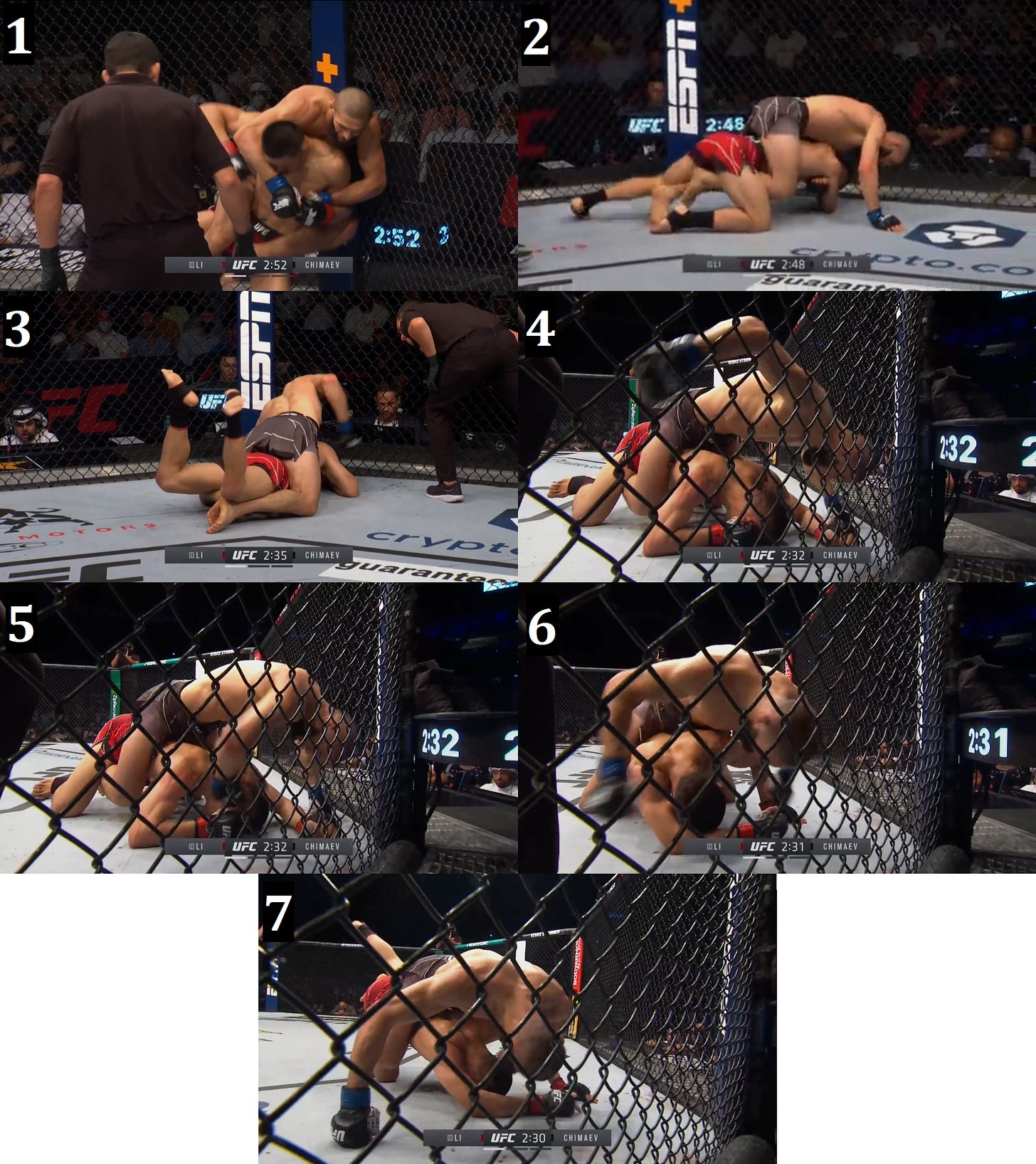Technique breakdown: Khamzat Chimaev and the science of smesh
Bloody Elbow's Connor Ruebusch breaks down the gamebreaking ground and pound of UFC contender Khamzat Chimaev.
Khabib Nurmagomedov was UFC lightweight champion for a little over two years. He defended his belt only three times and then retired, on top and in his prime, just one month after his 32nd birthday.
Though Nurmagomedov’s time in the sun was short, few fighters can boast a greater impact on the sport. MMA has ever been subject to trends and fads, but Khabib’s impact goes far beyond that. His style was not a bag of tricks, a series of shallow mannerisms to be emulated one day and forgotten the next. He had a system, unique to himself and his region of the world. With it, he changed the game forever.
But among all the imitators and hangers-on, only two stand out as worthy heirs of Khabib’s method. And both are fighting this weekend, in the main and co-main events of UFC 294.
In Islam Makhachev we see all the technical and strategic brilliance of Khabib. Nurmagomedov’s protege, Makhachev pairs Khabib’s characteristically perfect gameplans with equally perfect technique. If anything, Islam is more clinical, more precise than his forebear; the Sergio Pettis to Khabib’s Anthony.
But it is in the co-main event that we see a reflection of the other side of Khabib, the overwhelming physical force that so shocked the MMA world. Chimaev is Chechen, not Dagestani (or Avar, to be more precise). And he is no protege of Nurmagomedov’s. In fact, Chimaev got into a scuffle with Khabib’s cousin, Abubakar, just after Makhachev won the belt that was once Khabib’s (the beef has since been squashed). But where Makhachev inherited Nurmagomedov’s brilliance, it is Chimaev who mirrors his ferocity. Nowhere more so than in his ground striking, or ground and pound.
Ground and pound is not much analyzed, which is a little odd considering that it is this phase of the fight which really separates MMA from other combat sports. For fans, and even many fighters, ground striking is an afterthought, a chaotic, flailing operation which serves to finish off a compromised opponent, or a perfunctory bit of business intended only to prevent the referee from taking away a dominant position.
But ground and pound is no less an art and a science than any other aspect of martial arts. There are principles and techniques, strategies and tactics. More than that, ground and pound is the link between all the various parts of this sport.
Ground and pound is not just a part of MMA; it is MMA. And no one does it better than Khamzat Chimaev.
The principle of leverage
One of the challenges of striking in the grappling phase is stance. Namely the fact that there is none. Stance is perhaps the single most important element of any striking style: how a fighter stands determines which strikes are available to him, and the amount of power with which he can deliver them. Balance is essential. Without good balance, a fighter may deliver one strike with authority, but will struggle to follow-up with anything else, and may find himself unable to cope with anything coming back his way. Balance begets security, and leverage.
But there is no stance on the ground, per se. A fighter in top position has gravity on his side, but even so it can be difficult to strike with enough force to end the fight, either by knockout, or by forcing the opponent into position for a submission.
What is stance?
In a word, a stance requires two points of contact with the ground—two anchors with which leverage can be generated. On the feet, these anchors are… well, feet. But the same concept applies on the ground, even without a single toe touching the floor.
Let’s take a look at a sequence from Chimaev’s fight with China’s Li Jingliang.
1. Threatening the rear naked choke from a leg ride, Chimaev creates enough of a distraction to sneak his second foot around Li’s hip, securing back mount.
2. Chimaev declines to grab a seatbelt grip, opting instead for a strong underhook and a post; even with full back control, he wants to ensure that he stays on top of Li.
3. Together with the boots, Chimaev’s underhook is enough to flatten Li out. He proceeds to hammer away with his right hand.
4. But Li insists on building his base back up. Raising his hips makes Chimaev’s perch more precarious. Chimaev posts with his left hand…
5. …and belts away with his right.
6. Now Li shifts his weight to the right.
7. Chimaev simply switches hands. The right hand posts, and the left goes to work on Li’s face.
The sequence begins with Chimaev in back mount, both hooks in. The ideal jiu jitsu position…
But right from the jump, Chimaev’s attitude is not necessarily that of a pure submission grappler. Were he, say, Demian Maia, he might be happy to allow Li to roll him over onto his back. The threat of the rear naked choke would be no less viable from that position; he might even trade his hooks for a body triangle, and keep Li prisoner for the rest of the round, patiently hunting the submission.
Instead, Chimaev approaches the back mount more like a wrestler’s double leg ride. Instead of devoting both hands to a seatbelt grip, or double underhooks, either of which would make his control of the back all but absolute, Chimaev keeps a hand free to post. An anchor, ready to counteract whatever bumps and bucks Li can muster. Chimaev doesn’t just want to choke Li out; he wants to batter him with powerful strikes, keep up the relentless pressure so reminiscent of Khabib. He would be happy to give up back mount altogether, so long as he stays on top.
That post is essential. The only downside of back mount, from a striking perspective, is that it requires both legs working in concert–essentially turning two potential anchors into one. An effective, two-handed assault is still possible from this position, especially when Li is flattened out on his belly (the two knees of the fighter on top work well enough as anchors), but no fighter with any fight left in him will allow himself to be pancaked so easily. And as long as the man on bottom prevents his hips being driven to the floor, the single anchor of the hips will be an unstable one. Striking from such a position would be akin to punching on one leg: possible, but far from ideal.
Thus Chimaev creates another anchor. One hand is enough to pummel a fighter in such a compromised position, and so Chimaev devotes his other arm to the task of securing his base. He posts one hand on the ground and, together with the body triangle, his “stance” is now complete, allowing him to deliver a savage barrage of fully leveraged strikes with his free hand.
In a bind
Now, it’s one thing to rain down strikes from a fully secured back mount. In such a dominant position, you don’t exactly have to be Khamzat Chimaev to do serious damage. Principles don’t go out the window, but they’re free to wander into the other room for a bit.
Ground and pound gets a lot more interesting in more fluid positions, when the opponent has some freedom to move. Expert grapplers and wrestlers control such transitional positions using specific points of control—powerful grips which can be used to manipulate the opponent’s body, or keep them in place in order to maneuver around them. If a posted arm or leg anchors a fighter to the ground, then these points of control anchor him to the opponent.
For our purposes, we will call these anchors, simply, “holds.” This term usually applies to grips achieved with the hands, but I would propose a broader definition, one which comprises all manner of grips, binds, frames—any maneuver that restricts the opponent such that the attacker may advance in a controlled manner.
What is a hold, by this definition? Well, the hooks used to secure back mount are one example. Likewise for the body triangle. These are perhaps the strongest holds available to a grappler, as they control the opponent’s hips, the fulcrum of his body and its center of gravity.
But there are other parts of an opponent’s body that can be bound up and controlled, other levers to operate, with grips that allow for greater movement on the part of the opponent—but only in one or two specific directions. The head is one such lever. Control a fighter’s head, and you control his posture. Thus the front headlock is a very useful hold, as are the family of holds known as nelsons. A simple frame or corssface would also fit the definition. Likewise for the figure-four or kimura grip, and its cousins the omoplata and the chicken wing, as well as the armbar (the wrestling version, not the jiu jitsu one). These holds lock up the opponent’s arm, and manipulate his body via the fulcrum of his shoulder.
But the favorite hold of Khamzat Chimaev is one popularized by Khabib Nurmagomedov—so much so that MMA fans named it after his part of the world. They call it the Dagestani handcuff.
Here’s Chimaev using it to brutalize Rhys McKee.
Keep reading with a 7-day free trial
Subscribe to The MMA Draw Newsletter to keep reading this post and get 7 days of free access to the full post archives.





